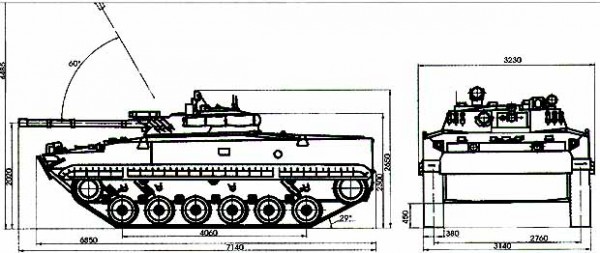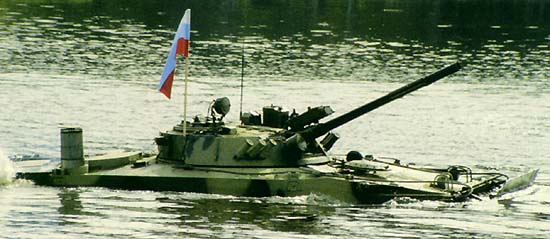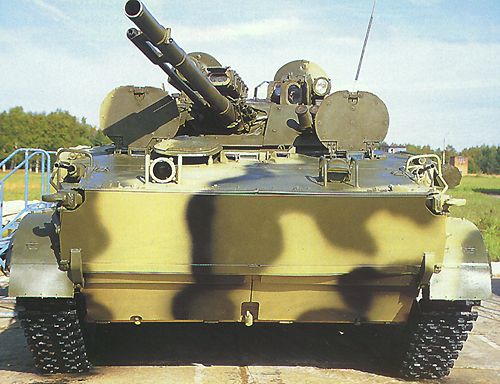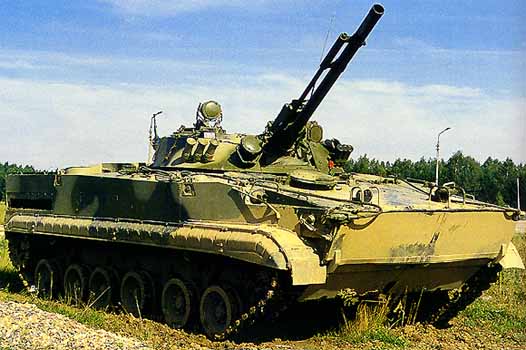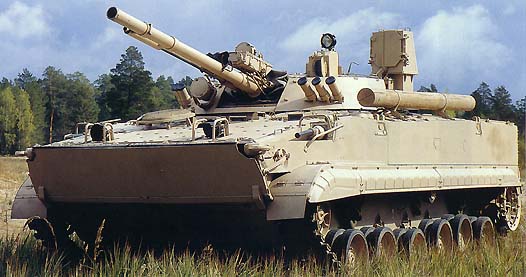Early in the 1960s,a group of designers, headed by P. Isakov, developed the widely known mechanized infantry combat vehicle, BMP-1. It was designed primarily to enhance troop combat mobility and offer armor protection to infantrymen fighting with tank support.
This combat vehicle gave birth to new trends in worldtank building and initiated new approaches to tactical employment of motorized infantry subunits. Combat vehicles intended for similar combat tasks were adopted by foreign armies much later. At first their combat employment was much discussed. Some analysts shared views that the MICVs should be used as a means of armored transportation designed to move infantrymen to the battlefield to follow up after tanks and capture combat areas.
However, it was considered expedient to equip them with some armament. The main armament of the BMP-1 was a 73 mm smoothbore gun capable of delivering fire at a distance of up 1,000 meters to hit armored vehicles, including old generation tanks. It was set up no other tasks. After long debates during the production process and comparative tests of several vehicles, proponents of automatic armament for the vehicle gained the upper hand: it was equipped with a 30mm automatic gun and the antitank guided missile (ATGM) “Konkurs”, designed by the Instrument Design Bureau in the town of Tula.
This considerably expanded the scope of its combat missions and enhanced the combat capabilities of the vehicle as a whole. But it remained a lot to be done to find a final concept for the vehicle’s combat employment, its missions and general appearance. This was achieved during further development of the BMP-3 and its armament. The Instrument Design Bureau in Tula was the leading developer of the BMP-3 armament system while the machine building plant in the town of Kurgan developed the vehicle. An armament system able to cope with a full range of combat missions assigned to infantry subunits, was developed after research findings.
For the first time the MICV was equipped with a 30 mm automatic gun, a 100 mm gun with moderate ballistics and a 7,62 mm machine gun (MG). A 100 mm gun fired both HE (High Explosive) shells and guided missiles. The very choice of ballistic solution (Vo=250 m/sec) provided for the development of a small weight gun and ensured that the shell met the target at major angles, thereby increasing the area of destruction and decreasing range errors and their dependence on the range of fire. The cannon launch of guided missiles in conjunction with a laser beam gun-laying control system and an independent twoplane aiming line stabilizer ensured launch of ATGMs on the move, a high rate of fire, noise- immunity and safety of the crew.
The rigid coaxiality of a 30 mm gun and the barrel of a 100 mm gun, coupled with the high precision and dynamic characteristics of the powerful stabilizer ensure high accuracy in its firing. For the first time in national and world practice the MICV was equipped with an automatic fire control system, which provided automatic angles of sight and lead, as well as precise corrections within a wide range of angles of elevation and the firing of all types of weapons from the stationary position, on the move and afloat. The high combat effectiveness of the armament system and capability to act independently on the battlefield is ensured by a great range of ammunition, including eight guided missiles, forty HE shells, 500 rounds for an automatic gun and 6,000 cartridges for machine-guns. There are four compartments in the hull of the vehicle: driver’s compartment, fighting compartment, troop compartment and powerplant compartment. The driver’s compartment is arranged in the front part of the hull. There are three stations: one for the driver in the middle and two for the machine-gunners on both sides of the driver’s seat. The fighting compartment is arranged in the middle of the hull where the stations for a commander and gunner are located. The main armaments are mounted in the turret. The gun ammunition supply is stowed in an stowage rack under the turntable. The armament control equipment includes: a sight (laying unit), a ground and air fire sight, a combined vision (day and night vision) device, ballistic computer. Machine guns mounted autonomously in the front part of the vehicle comprise a sight with a fiber-optical pipper display system.
The main armaments are stabilized in two planes. There is also terrain navigation equipment. The commander’s station is equipped with a radio-transmitter, R-173, and a radio-receiver, R-173P. The seven-seat troop compartment is arranged behind the fighting compartment. Two are individual seats and five are group seats located near the engine compartment bulkhead. There are air ducts here to provide clean air for the troops. There are also boxes with daily rations for the personnel and SPTA boxes. Armored firing portholes are located in the vehicle’s hull sides. Three hatches are provided in the front part of the vehicle and two hatches on the turret both for the crew and troop. There are three hatches in the front part of the vehicle and two hatches on the turret both for the crew and troops. There are also rear doors and hinged front covers in the hull. The powerplant compartment is arranged directly after the troop compartment. Both compartments are separated by an inner soundproof wall. The powerplant compartment houses an engine, power transmission assemblies and corresponding systems. Removable covers and ports provide easy access to the engine and power transmission assemblies. The vehicle’s track and suspension system comprises six road wheels and support rollers. The road wheels have double disks with externally cushioned rubber supports. The independent hydropneumatic suspension has a big dynamic road wheel travel. Thanks to such design it has proved possible to maintain the vehicle’s smooth movement in the off-road conditions at any speed without jerking and swinging. The track and suspension system of the BMP-3 has a large safety margin, enabling its use in a number of various-purpose vehicles. The BMP-3 moves in water via hydrojets and not by track drive systems as was the case with the BMP-1 and BMP-2. The outstanding performance of the BMP-3 was demonstrated dramatically during its field tests in the Arabian desert as recounted by two participants, first deputy chief of the Armor Department of the Ministry of Defence of the Russian Federation, Lieutenant-General N. Zhuravlev and deputy chief designer of the Tula Instrument Design Bureau, Doctor of Technical Sciences, S. Berezin. On July 27, 1991 a giant-aircraft, the “Ruslan”, landed in Abu-Dhabi airport. Four BMPs-3 rolled off, accompanied by curious glances of the army officers of the United Arab Emirates. This didn’t signify that the combat vehicles had been chosen by the Arab authorities and had become lawful “residents” of that country. On the contrary, it was only the beginning of the road to recognition of Russian armaments by a country, which traditionally bought English or other Western weaponry. The first acquaintance of the top brass of the UAE with Russian vehicles didn’t bring much cause for optimism to our specialists.
The Arab military knew a lot about the combat capabilities of similar classes of vehicles produced by the NATO countries and were not very much sanguine with the “know-how” of the BMP-3. More than that: they predicted its failure during the forthcoming field tests. The “D-day” for the tests was repeatedly postponed. Specialists caviled at study of the vehicle’s design and meticulously scheduled the forthcoming tests. All suggestions by our side were politely rejected, while, according to unofficial information, everything was made ready for tests of the American MICVs “Bradley” and English “Warrior”. At last the test day came. The Brigadier-General, head of the Arab inspection group, assigned the mission in the following way: he would drive his Rover “Toyota”, while our column should closely follow along the sand-hills. The first phase of the test would be considered performed, if our BMPs managed to follow his Rover. The ambient temperature was +60°C. The sand blizzards began to blow. The sand clogged the eyes and ears, cut at the neck and face. The engines worked on the brink of stalling. The vehicles had to negotiate sand-hills at 30° and “dive” from them at 80°. The vehicles became stuck in the canyons. In such cases we had to tow the machine via the other three vehicles linked together in tandem. Sometimes it looked as if one more problem would arise and that neither materiel or personnel could survive any longer. It seemed a mere miracle, when after a seven hours march our column finally reached an earth road. We were happy to learn that our BMP-3 had managed to overcome terrain, which proved unsurpassable for all other MICVs, including the famous “Bradley”. After inspecting the column the Brigadier-General said: “O.K.” and issued an order:”Forward!” A 200 hundred kilometers race began at full speed along earth roads. The vehicles were stretched to the limit of their capabilities. Arab officers who drove our BMPs were determined to reveal weak spots in the vehicle’s design. The march continued for three days in violation of all operational manuals and other regulatory documents. Racing continued at maximum speeds for 16-17 hours a day. Stops for respite and check-ups were made after 5-7 hours of continued movement.
Exhausted personnel were allowed only a short rest at night. The inspecting commission concluded that the BMP-3 surpassed similar vehicles of the NATO countries in terms of cruising capabilities. Nevertheless, we had only won half of the battle. Now we had to fire all sorts of armament at targets of opportunity at various ranges. Convinced of the weaponry, our specialists agreed to all the terms set by the Arab officers. However, when they reached the firing range they realized that a lot had to be done on the spot from scratch. Firing had to be executed only on the move. The vehicles had to move along two circles situated on both sides by an “imaginary” control tower. The firing had to be made from any points at any targets located at various ranges. The firing started with missiles launched at maximum ranges. After the first six missiles had been launched, Brigadier-General and the leader of the Russian delegation inspected the targets. We noted that every target had been hit three times. The General was experienced enough to know that there were no combat vehicles in the world, which could cannon launch anti-tank missiles on the move. The combat capabilities of other types of the armaments were well known to him and were demonstrated at the firing range by both Russian and Arab experts. The high combat effectiveness of all types of armament and their trouble-free operation during firing and training made members of the commission voice their support for the BMP-3. Numerous meetings with the military of the UAE were marked by considerable tension, but were conducted in an atmosphere of sincerity, competence and mutual esteem. The Russian delegation was well aware that the Government of the UAE had decided in the wake of the Gulf War to tailor a modern army of their own equipped with state-of- the-art weaponry. Naturally, Western countries were eager to offer their aircraft, tanks, anti-aircraft artillery and other materiel to their Arab clients. All this was taken into consideration by the commission in its report on the BMP-3 tests and their views on future cooperation with Russia in the military domain.
Russian specialists drew the attention of their clients to the light weight of the BMP-3, its ability to easily cross various water obstacles, fire anti-tank missiles on the move, and its air-transportability. The Arab military highly appraised the vehicle as a whole and asked that it be adapted to meet the requirements of their region, namely to improve troop apartment conditions, to update the cooling system of the engine, and to put rubber grousers. Finally, the Russian delegation was received by the President of the UAE. He said that the BMP-3 had been highly appraised by the military, despite the fact that it had been tested to failure. This reason had compelled him to take a vital political decision to cooperate with Russia in the military field. This marked the end of the field tests in the Arab desert, where our combat materiel displayed the high quality of Russian weapons and “defended” its world reputation.
